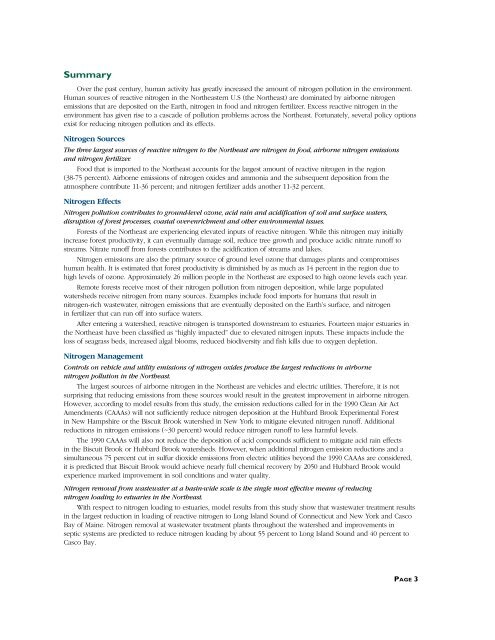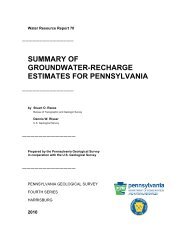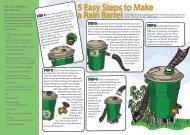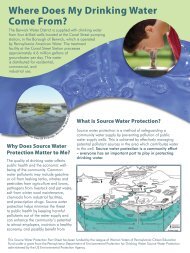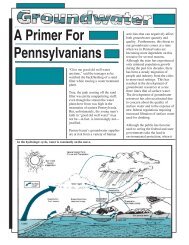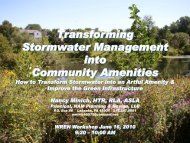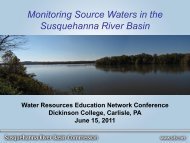NITROGEN POLLUTION: - Hubbard Brook Research Foundation
NITROGEN POLLUTION: - Hubbard Brook Research Foundation
NITROGEN POLLUTION: - Hubbard Brook Research Foundation
You also want an ePaper? Increase the reach of your titles
YUMPU automatically turns print PDFs into web optimized ePapers that Google loves.
Summary<br />
Over the past century, human activity has greatly increased the amount of nitrogen pollution in the environment.<br />
Human sources of reactive nitrogen in the Northeastern U.S (the Northeast) are dominated by airborne nitrogen<br />
emissions that are deposited on the Earth, nitrogen in food and nitrogen fertilizer. Excess reactive nitrogen in the<br />
environment has given rise to a cascade of pollution problems across the Northeast. Fortunately, several policy options<br />
exist for reducing nitrogen pollution and its effects.<br />
Nitrogen Sources<br />
The three largest sources of reactive nitrogen to the Northeast are nitrogen in food, airborne nitrogen emissions<br />
and nitrogen fertilizer.<br />
Food that is imported to the Northeast accounts for the largest amount of reactive nitrogen in the region<br />
(38-75 percent). Airborne emissions of nitrogen oxides and ammonia and the subsequent deposition from the<br />
atmosphere contribute 11-36 percent; and nitrogen fertilizer adds another 11-32 percent.<br />
Nitrogen Effects<br />
Nitrogen pollution contributes to ground-level ozone, acid rain and acidification of soil and surface waters,<br />
disruption of forest processes, coastal over-enrichment and other environmental issues.<br />
Forests of the Northeast are experiencing elevated inputs of reactive nitrogen. While this nitrogen may initially<br />
increase forest productivity, it can eventually damage soil, reduce tree growth and produce acidic nitrate runoff to<br />
streams. Nitrate runoff from forests contributes to the acidification of streams and lakes.<br />
Nitrogen emissions are also the primary source of ground level ozone that damages plants and compromises<br />
human health. It is estimated that forest productivity is diminished by as much as 14 percent in the region due to<br />
high levels of ozone. Approximately 26 million people in the Northeast are exposed to high ozone levels each year.<br />
Remote forests receive most of their nitrogen pollution from nitrogen deposition, while large populated<br />
watersheds receive nitrogen from many sources. Examples include food imports for humans that result in<br />
nitrogen-rich wastewater, nitrogen emissions that are eventually deposited on the Earth’s surface, and nitrogen<br />
in fertilizer that can run off into surface waters.<br />
After entering a watershed, reactive nitrogen is transported downstream to estuaries. Fourteen major estuaries in<br />
the Northeast have been classified as “highly impacted” due to elevated nitrogen inputs. These impacts include the<br />
loss of seagrass beds, increased algal blooms, reduced biodiversity and fish kills due to oxygen depletion.<br />
Nitrogen Management<br />
Controls on vehicle and utility emissions of nitrogen oxides produce the largest reductions in airborne<br />
nitrogen pollution in the Northeast.<br />
The largest sources of airborne nitrogen in the Northeast are vehicles and electric utilities. Therefore, it is not<br />
surprising that reducing emissions from these sources would result in the greatest improvement in airborne nitrogen.<br />
However, according to model results from this study, the emission reductions called for in the 1990 Clean Air Act<br />
Amendments (CAAAs) will not sufficiently reduce nitrogen deposition at the <strong>Hubbard</strong> <strong>Brook</strong> Experimental Forest<br />
in New Hampshire or the Biscuit <strong>Brook</strong> watershed in New York to mitigate elevated nitrogen runoff. Additional<br />
reductions in nitrogen emissions (~30 percent) would reduce nitrogen runoff to less harmful levels.<br />
The 1990 CAAAs will also not reduce the deposition of acid compounds sufficient to mitigate acid rain effects<br />
in the Biscuit <strong>Brook</strong> or <strong>Hubbard</strong> <strong>Brook</strong> watersheds. However, when additional nitrogen emission reductions and a<br />
simultaneous 75 percent cut in sulfur dioxide emissions from electric utilities beyond the 1990 CAAAs are considered,<br />
it is predicted that Biscuit <strong>Brook</strong> would achieve nearly full chemical recovery by 2050 and <strong>Hubbard</strong> <strong>Brook</strong> would<br />
experience marked improvement in soil conditions and water quality.<br />
Nitrogen removal from wastewater at a basin-wide scale is the single most effective means of reducing<br />
nitrogen loading to estuaries in the Northeast.<br />
With respect to nitrogen loading to estuaries, model results from this study show that wastewater treatment results<br />
in the largest reduction in loading of reactive nitrogen to Long Island Sound of Connecticut and New York and Casco<br />
Bay of Maine. Nitrogen removal at wastewater treatment plants throughout the watershed and improvements in<br />
septic systems are predicted to reduce nitrogen loading by about 55 percent to Long Island Sound and 40 percent to<br />
Casco Bay.<br />
PAGE 3


